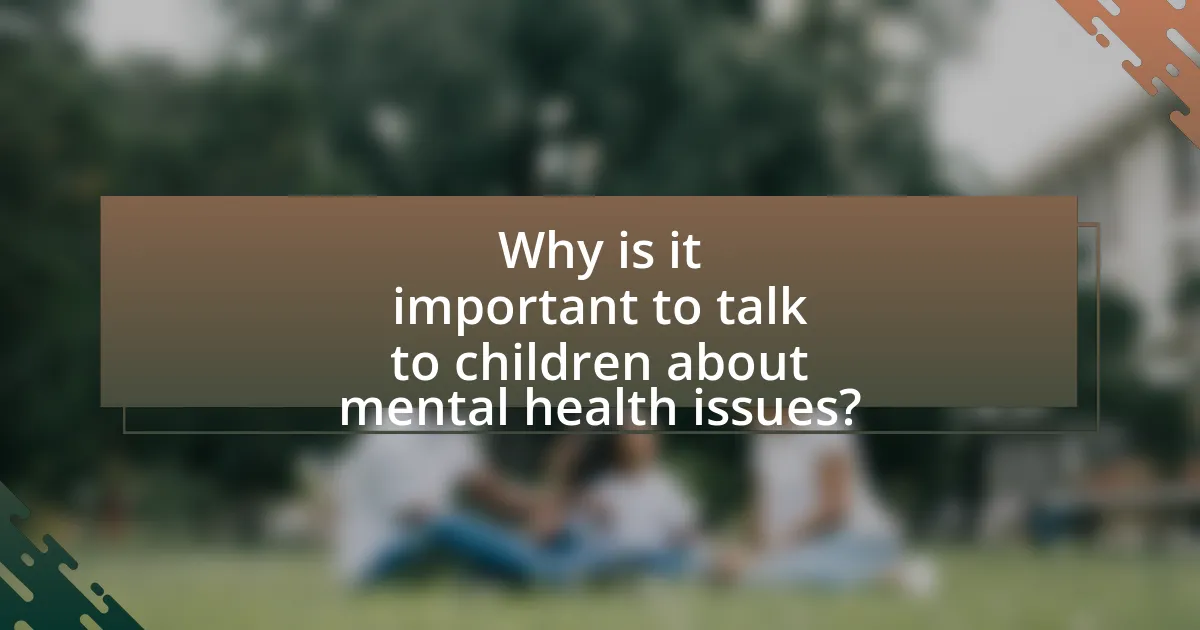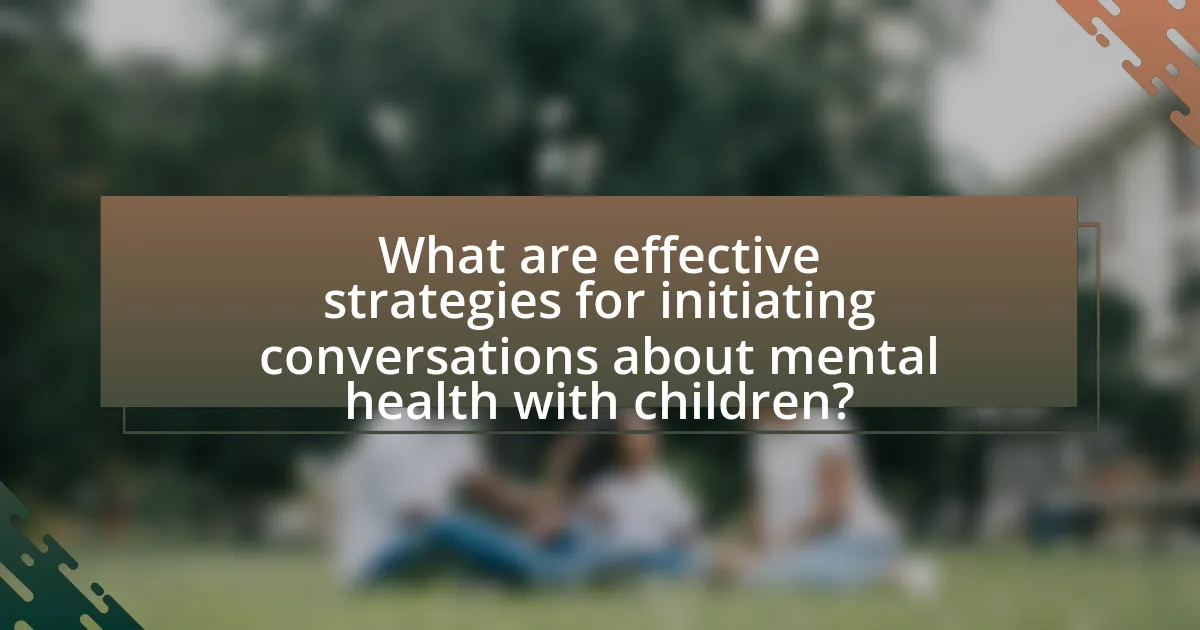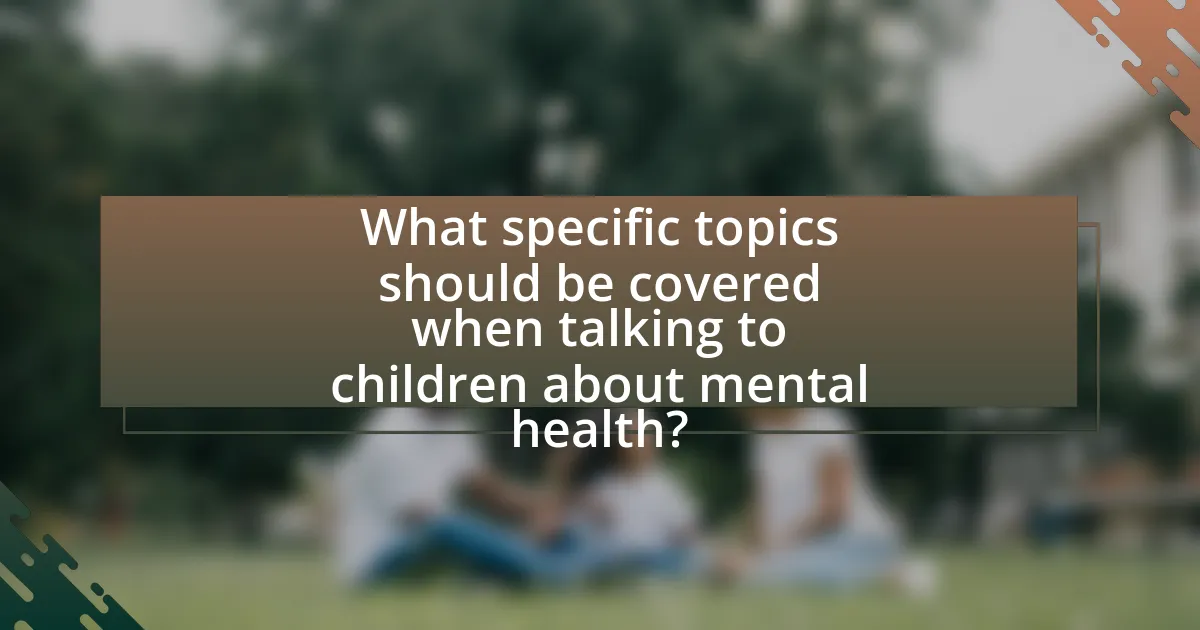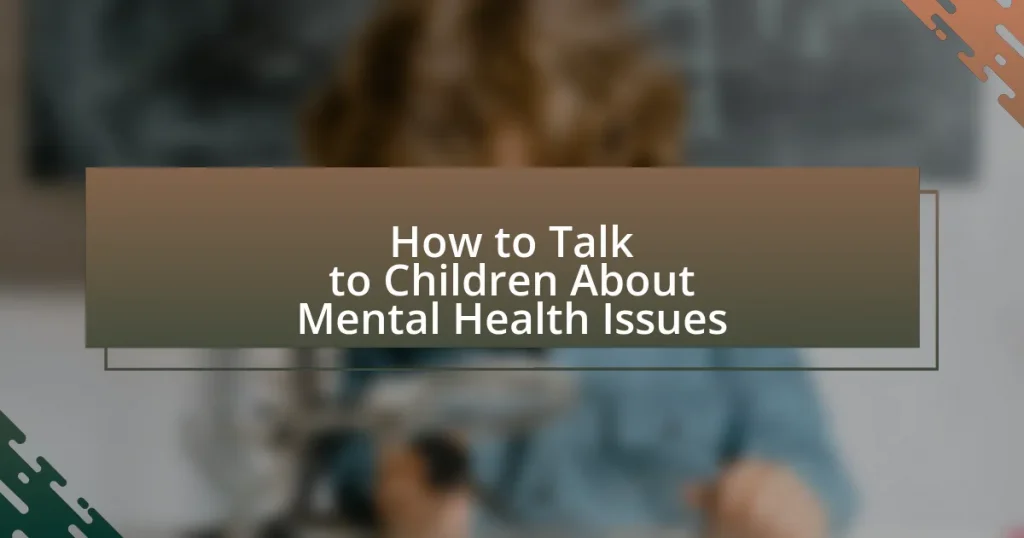The article focuses on the importance of discussing mental health issues with children, emphasizing the need for open communication to foster understanding and reduce stigma. It outlines the potential impacts of mental health problems on children’s emotional, social, and academic development, and highlights the signs that may indicate a child is struggling. The article also provides effective strategies for parents to initiate conversations about mental health, including using age-appropriate language and creating a safe environment. Additionally, it discusses common mental health issues children may face, such as anxiety and depression, and offers practical tips for parents to support their children’s mental well-being.

Why is it important to talk to children about mental health issues?
Talking to children about mental health issues is important because it fosters understanding and reduces stigma. Open discussions help children recognize their emotions and develop coping strategies, which is crucial as studies show that early intervention can significantly improve mental health outcomes. For instance, research published in the Journal of the American Academy of Child & Adolescent Psychiatry indicates that children who receive education about mental health are more likely to seek help when needed, leading to better long-term mental health.
What are the potential impacts of mental health issues on children?
Mental health issues can significantly impair children’s emotional, social, and academic development. These issues may lead to difficulties in forming relationships, increased risk of academic failure, and heightened vulnerability to substance abuse. For instance, children with anxiety disorders often struggle with school attendance and performance, as evidenced by a study published in the Journal of the American Academy of Child and Adolescent Psychiatry, which found that anxiety can lead to lower grades and increased dropout rates. Additionally, mental health problems can result in behavioral issues, such as aggression or withdrawal, which further complicate social interactions and peer relationships.
How can mental health issues affect a child’s development?
Mental health issues can significantly hinder a child’s development by impacting their emotional, social, and cognitive growth. Children experiencing mental health challenges may struggle with forming relationships, regulating emotions, and achieving academic success. For instance, research indicates that children with anxiety disorders often face difficulties in social interactions and may exhibit lower academic performance due to their inability to concentrate in stressful situations. Additionally, a study published in the Journal of the American Academy of Child & Adolescent Psychiatry found that untreated mental health issues can lead to long-term consequences, including increased risk of substance abuse and chronic health problems. Thus, addressing mental health concerns early is crucial for fostering healthy development in children.
What signs might indicate a child is struggling with mental health issues?
Signs that indicate a child is struggling with mental health issues include significant changes in behavior, mood, or academic performance. For instance, a child may exhibit increased irritability, withdrawal from friends and family, or a decline in school grades, which can signal underlying mental health concerns. Research shows that approximately 1 in 5 children experience mental health disorders, highlighting the importance of recognizing these signs early. Additionally, physical symptoms such as unexplained headaches or stomachaches can also be indicators of emotional distress.
How can open conversations about mental health benefit children?
Open conversations about mental health can significantly benefit children by fostering emotional awareness and reducing stigma. When children engage in discussions about mental health, they learn to identify and express their feelings, which enhances their emotional intelligence. Research indicates that children who openly discuss mental health issues are more likely to seek help when needed, leading to better mental health outcomes. For instance, a study published in the Journal of Child Psychology and Psychiatry found that children who participated in mental health discussions showed improved coping strategies and resilience. This proactive approach not only normalizes mental health conversations but also equips children with the tools to navigate their emotional challenges effectively.
What role does communication play in a child’s understanding of mental health?
Communication is essential in shaping a child’s understanding of mental health. It facilitates the exchange of information, emotions, and experiences, allowing children to articulate their feelings and comprehend mental health concepts. Research indicates that open dialogue about mental health can reduce stigma and promote emotional literacy, enabling children to recognize and express their own mental health needs. For instance, a study published in the Journal of Child Psychology and Psychiatry found that children who engage in conversations about emotions with caregivers are more likely to develop better emotional regulation skills. This underscores the importance of effective communication in fostering a supportive environment for children’s mental health awareness and understanding.
How can discussing mental health reduce stigma for children?
Discussing mental health can significantly reduce stigma for children by normalizing conversations around emotional well-being. When children engage in open discussions about mental health, they learn that it is a common and acceptable topic, which helps to dismantle misconceptions and fears associated with mental health issues. Research indicates that early education on mental health can foster empathy and understanding, leading to a more supportive environment. For instance, a study published in the Journal of Child Psychology and Psychiatry found that children who participated in mental health awareness programs showed a decrease in stigma-related attitudes. This evidence supports the notion that proactive dialogue about mental health can create a culture of acceptance and reduce stigma among children.

What are effective strategies for initiating conversations about mental health with children?
Effective strategies for initiating conversations about mental health with children include using age-appropriate language, creating a safe and open environment, and modeling emotional expression. Age-appropriate language ensures that children can understand the concepts being discussed, which is crucial for effective communication. Creating a safe environment encourages children to share their feelings without fear of judgment, fostering trust. Additionally, modeling emotional expression allows children to see that discussing feelings is normal and healthy, making them more likely to engage in the conversation. Research indicates that open discussions about mental health can reduce stigma and promote emotional well-being in children, highlighting the importance of these strategies.
How can parents create a safe environment for discussing mental health?
Parents can create a safe environment for discussing mental health by fostering open communication and demonstrating empathy. Establishing a non-judgmental space encourages children to express their feelings without fear of criticism. Research indicates that children are more likely to share their thoughts when they perceive their parents as approachable and understanding (American Psychological Association, 2020). Additionally, parents should actively listen and validate their children’s emotions, reinforcing that it is normal to discuss mental health concerns. This approach not only builds trust but also normalizes conversations about mental health, making it easier for children to seek help when needed.
What techniques can be used to encourage children to express their feelings?
Techniques to encourage children to express their feelings include using open-ended questions, creating a safe environment, and incorporating play-based activities. Open-ended questions, such as “How did that make you feel?” allow children to articulate their emotions without feeling restricted. A safe environment, where children feel secure and supported, fosters openness and honesty in sharing feelings. Additionally, play-based activities, such as drawing or role-playing, can help children express emotions they may struggle to verbalize. Research indicates that children are more likely to communicate their feelings when they feel safe and understood, highlighting the importance of these techniques in promoting emotional expression.
How can parents model healthy conversations about emotions?
Parents can model healthy conversations about emotions by openly expressing their own feelings and discussing emotional experiences in a constructive manner. This approach encourages children to recognize and articulate their emotions, fostering emotional intelligence. Research indicates that children who observe their parents discussing emotions are more likely to engage in similar conversations, which enhances their ability to cope with emotional challenges. For instance, a study published in the Journal of Family Psychology found that parental emotional communication significantly influences children’s emotional understanding and regulation. By sharing personal feelings and validating their children’s emotions, parents create a safe environment for emotional expression, promoting mental well-being.
What age-appropriate language should be used when discussing mental health?
Age-appropriate language for discussing mental health with children includes simple, clear terms that they can understand, such as “feelings,” “sad,” “worried,” and “help.” For younger children, using analogies like “your brain is like a garden that needs care” can help them grasp complex concepts. Research indicates that children aged 5-7 benefit from concrete examples and visual aids, while those aged 8-12 can handle more abstract discussions about emotions and coping strategies. The National Institute of Mental Health emphasizes the importance of using relatable language to foster understanding and reduce stigma, ensuring that children feel safe to express their feelings.
How can parents tailor their language to different developmental stages?
Parents can tailor their language to different developmental stages by adjusting vocabulary, complexity, and emotional content to match their child’s cognitive and emotional maturity. For infants and toddlers, parents should use simple words, short sentences, and expressive tones to convey emotions, as young children respond well to non-verbal cues and basic language. As children enter preschool and early elementary years, parents can introduce more complex concepts and vocabulary, using storytelling and relatable examples to explain feelings and mental health issues. Research indicates that children aged 3 to 5 begin to understand basic emotions and can benefit from discussions that include feelings and simple explanations of mental health (Denham et al., 2012, “Emotional Development in Young Children,” Guilford Press). In later childhood, parents can engage in more in-depth conversations, encouraging critical thinking and emotional expression, as children aged 6 to 12 are better equipped to understand abstract concepts and the nuances of mental health. This progression ensures that language remains age-appropriate and effective in fostering understanding and emotional intelligence.
What resources can help parents find suitable language for discussions?
Parents can find suitable language for discussions about mental health issues through resources such as books, websites, and workshops specifically designed for this purpose. For instance, the National Alliance on Mental Illness (NAMI) offers guides and materials that provide age-appropriate language and strategies for discussing mental health with children. Additionally, the American Psychological Association (APA) provides articles and resources that help parents understand how to communicate effectively about mental health topics. These resources are validated by mental health professionals and are widely used in educational settings to promote healthy conversations.

What specific topics should be covered when talking to children about mental health?
When talking to children about mental health, specific topics that should be covered include emotions, coping strategies, the importance of seeking help, and the impact of mental health on daily life. Discussing emotions helps children identify and express their feelings, which is crucial for emotional intelligence. Teaching coping strategies equips them with tools to manage stress and anxiety effectively. Emphasizing the importance of seeking help normalizes the act of reaching out for support, making it clear that it is okay to talk to trusted adults about their feelings. Lastly, explaining how mental health affects daily life can help children understand the relevance of mental well-being in their own experiences. These topics are essential for fostering a supportive environment where children feel safe discussing mental health issues.
What are common mental health issues that children may face?
Common mental health issues that children may face include anxiety disorders, depression, attention-deficit/hyperactivity disorder (ADHD), and behavioral disorders. Anxiety disorders affect approximately 7% of children, manifesting as excessive worry or fear. Depression can impact around 3% of children, leading to persistent sadness and loss of interest in activities. ADHD affects about 5% of children, characterized by inattention, hyperactivity, and impulsivity. Behavioral disorders, such as oppositional defiant disorder, can also occur, affecting a child’s ability to follow rules and interact appropriately. These statistics highlight the prevalence and significance of mental health issues in children, emphasizing the need for awareness and intervention.
How can parents explain anxiety and depression to children?
Parents can explain anxiety and depression to children by using simple language and relatable examples. They should describe anxiety as a feeling of worry or fear that can make someone feel uneasy, and depression as a state of feeling sad or hopeless for an extended period. For instance, parents can say that just like physical illnesses, mental health issues can affect how we think and feel. Research indicates that children as young as six can understand basic concepts of mental health when explained appropriately, emphasizing the importance of open communication. By normalizing these feelings and encouraging children to express their emotions, parents can help them understand that it’s okay to seek help and talk about their feelings.
What should parents know about ADHD and its effects on children?
Parents should know that ADHD, or Attention-Deficit/Hyperactivity Disorder, significantly affects children’s behavior, learning, and social interactions. Children with ADHD often experience difficulties with attention, impulse control, and hyperactivity, which can lead to challenges in academic settings and relationships with peers. Research indicates that approximately 5% of children worldwide are diagnosed with ADHD, highlighting its prevalence and impact. Furthermore, studies show that children with ADHD are at a higher risk for developing additional mental health issues, such as anxiety and depression, which can further complicate their emotional and social development. Understanding these effects allows parents to seek appropriate interventions and support, fostering a more conducive environment for their child’s growth and well-being.
How can parents address the importance of seeking help?
Parents can address the importance of seeking help by openly discussing mental health and modeling help-seeking behaviors. By initiating conversations about emotions and challenges, parents create an environment where children feel safe to express their feelings. Research indicates that children who observe their parents seeking help for their own mental health issues are more likely to seek help themselves, as demonstrated in a study published in the Journal of Child Psychology and Psychiatry, which found a correlation between parental behavior and children’s attitudes toward seeking assistance. This proactive approach not only normalizes the act of seeking help but also reinforces the idea that mental health is a priority.
What steps can children take if they feel overwhelmed?
Children can take several steps if they feel overwhelmed, including identifying their feelings, taking deep breaths, and seeking support from trusted adults. Recognizing emotions helps children articulate their experiences, while deep breathing can reduce anxiety by promoting relaxation. Research indicates that talking to a trusted adult, such as a parent or teacher, can provide emotional support and guidance, which is crucial for managing overwhelming feelings effectively.
How can parents guide children in finding professional help?
Parents can guide children in finding professional help by initiating open conversations about mental health and encouraging them to express their feelings. By actively listening and validating their emotions, parents create a safe environment where children feel comfortable discussing their struggles. Research indicates that children who perceive their parents as supportive are more likely to seek help when needed. Parents can also assist by identifying appropriate mental health professionals, such as therapists or counselors, and discussing the benefits of therapy. Providing resources, such as contact information for local mental health services, further empowers children to take the next steps in seeking help.
What practical tips can parents use to support their children’s mental health?
Parents can support their children’s mental health by fostering open communication, establishing routines, and encouraging physical activity. Open communication allows children to express their feelings and concerns, which is crucial for emotional well-being. Research indicates that children who feel heard are more likely to develop resilience and coping skills. Establishing routines provides a sense of stability and security, which can reduce anxiety. Additionally, encouraging physical activity is essential, as studies show that regular exercise can significantly improve mood and reduce symptoms of depression and anxiety in children.
How can parents encourage healthy coping mechanisms in children?
Parents can encourage healthy coping mechanisms in children by modeling effective emotional regulation and providing supportive environments. When parents express their own feelings and demonstrate coping strategies, such as deep breathing or problem-solving, children learn to emulate these behaviors. Research indicates that children who observe their parents managing stress effectively are more likely to adopt similar strategies, fostering resilience. Additionally, creating a safe space for open discussions about emotions allows children to articulate their feelings, which is crucial for developing coping skills. Studies show that children who engage in regular conversations about mental health are better equipped to handle stress and anxiety.
What activities can promote mental well-being in children?
Engaging in physical activities, such as sports or outdoor play, can significantly promote mental well-being in children. Research indicates that regular physical activity releases endorphins, which enhance mood and reduce feelings of anxiety and depression. Additionally, creative activities like art, music, and dance foster self-expression and emotional regulation, contributing to improved mental health. Social interactions through group activities or team sports also build resilience and social skills, which are crucial for emotional well-being. Studies show that children who participate in structured activities exhibit lower levels of stress and higher levels of happiness.
